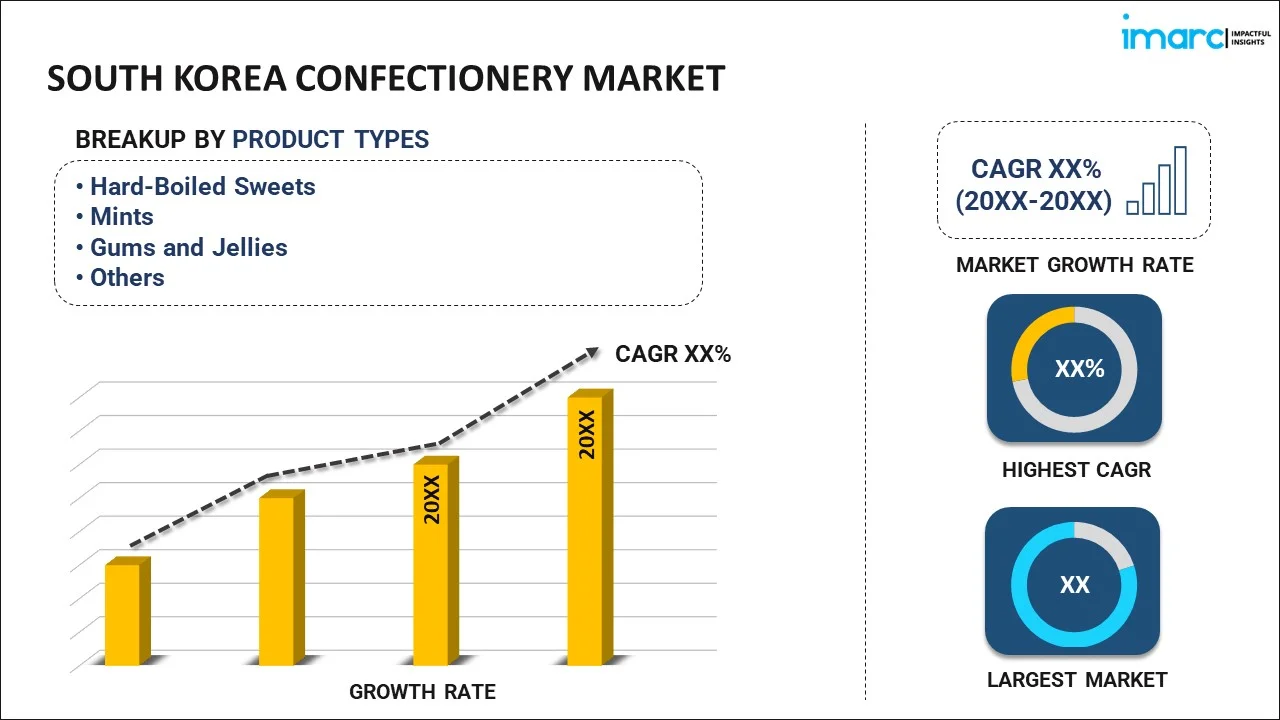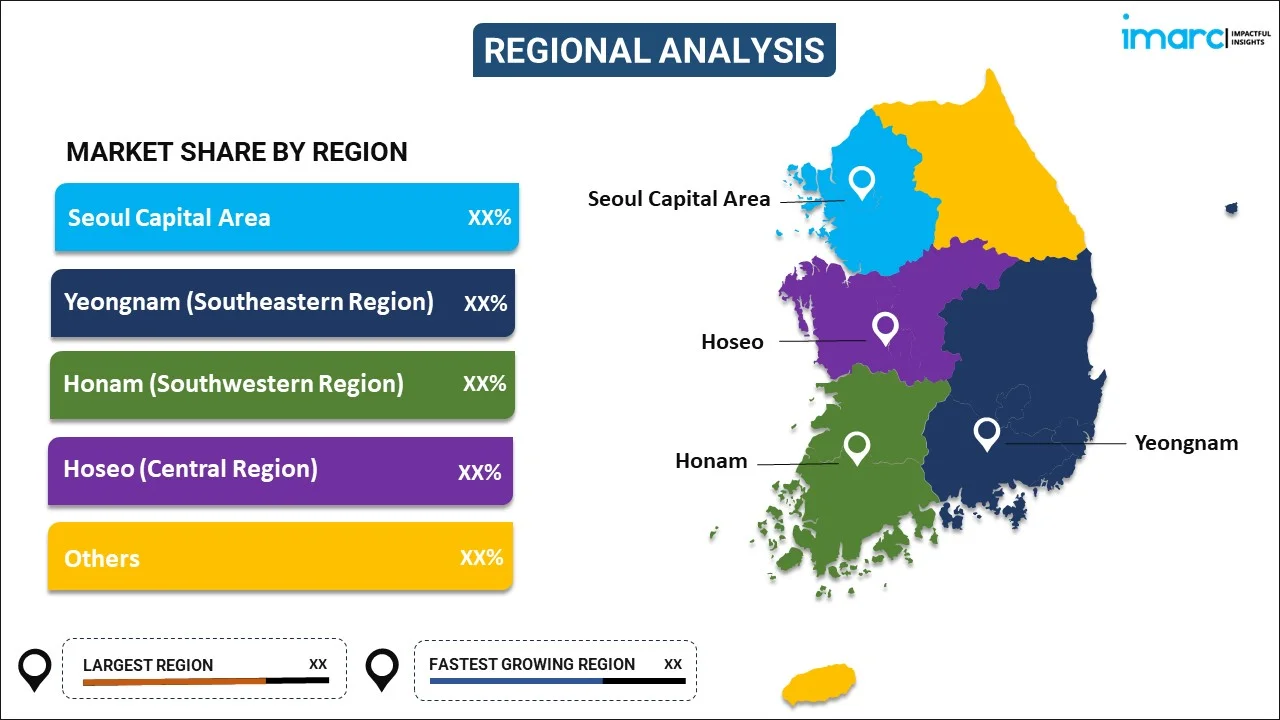
South Korea Confectionery Market Report by Product Type (Hard-Boiled Sweets, Mints, Gums and Jellies, Chocolate, Caramels and Toffees, Medicated Confectionery, Fine Bakery Wares, and Others), Age Group (Children, Adult, Geriatric), Price Point (Economy, Mid-Range, Luxury), Distribution Channel (Supermarkets and Hypermarkets, Convenience Stores, Pharmaceutical and Drug Stores, Online Stores, and Others), and Region 2025-2033
Market Overview:
South Korea confectionery market size reached USD 3.8 Billion in 2024. Looking forward, IMARC Group expects the market to reach USD 4.7 Billion by 2033, exhibiting a growth rate (CAGR) of 2.3% during 2025-2033. The continuous product innovation, including the introduction of new flavors, shapes, and packaging, which can attract a wide range of consumers, is driving the market.
|
Report Attribute
|
Key Statistics
|
|---|---|
|
Base Year
|
2024 |
|
Forecast Years
|
2025-2033 |
|
Historical Years
|
2019-2024
|
| Market Size in 2024 | USD 3.8 Billion |
| Market Forecast in 2033 | USD 4.7 Billion |
| Market Growth Rate (2025-2033) | 2.3% |
Confectionery refers to a diverse array of sweet food items, often characterized by their sugar content and varied textures. It has evolved from simple honey and nut-based treats to a vast assortment of candies, chocolates, pastries, and other sugary delights. Confectionery experienced a significant transformation with the industrial revolution, as technological advancements enabled mass production and widespread accessibility. Iconic treats like taffy, fudge, and bonbons gained popularity, reflecting the era's changing tastes and cultural influences. Confectionery not only served as a source of indulgence but also became intertwined with social customs and celebrations. The confectionery landscape laid the foundation for the vibrant and diverse world of sweets, showcasing the enduring appeal of these delightful creations across generations.
South Korea Confectionery Market Trends:
The confectionery market in South Korea is experiencing robust growth, primarily driven by changing consumer preferences and lifestyle trends. To begin with, the increasing demand for indulgent and premium sweets has propelled the confectionery sector to new heights. Consumers are increasingly seeking unique and exotic flavors, driving innovation and product development within the industry. Moreover, the rising disposable income of the regional population has led to an uptick in discretionary spending on confectionery items, bolstering market expansion. In addition to this, the growing awareness of health and wellness has not dampened the confectionery market but has instead prompted manufacturers to introduce healthier alternatives. Consequently, the development of low-sugar, organic, and functional confectionery products has opened up new avenues for growth. Furthermore, the convenience and on-the-go consumption trend has become a significant driver for the confectionery market. Single-serve packaging, innovative formats, and portable options have gained popularity, catering to the busy, modern lifestyle. In summary, the confectionery market's dynamic growth can be attributed to a confluence of factors, ranging from evolving consumer preferences for premium treats to the industry's adaptation to health-conscious demands and the emphasis on convenience in product offerings. As these trends continue to shape consumer behavior, the confectionery market in South Korea is poised for sustained expansion in the foreseeable future.
South Korea Confectionery Market Segmentation:
IMARC Group provides an analysis of the key trends in each segment of the market, along with forecasts at the country level for 2025-2033. Our report has categorized the market based on product type, age group, price point, and distribution channel.
Product Type Insights:

- Hard-boiled Sweets
- Mints
- Gums and Jellies
- Chocolate
- Caramels and Toffees
- Medicated Confectionery
- Fine Bakery Wares
- Others
The report has provided a detailed breakup and analysis of the market based on the product type. This includes hard-boiled sweets, mints, gums and jellies, chocolate, caramels and toffees, medicated confectionery, fine bakery wares, and others.
Age Group Insights:
- Children
- Adult
- Geriatric
A detailed breakup and analysis of the market based on the age group have also been provided in the report. This includes children, adult, and geriatric.
Price Point Insights:
- Economy
- Mid-range
- Luxury
The report has provided a detailed breakup and analysis of the market based on the price point. This includes economy, mid-range, and luxury.
Distribution Channel Insights:
- Supermarkets and Hypermarkets
- Convenience Stores
- Pharmaceutical and Drug Stores
- Online Stores
- Others
A detailed breakup and analysis of the market based on the distribution channel have also been provided in the report. This includes supermarkets and hypermarkets, convenience stores, pharmaceutical and drug stores, online stores, and others.
Regional Insights:

- Seoul Capital Area
- Yeongnam (Southeastern Region)
- Honam (Southwestern Region)
- Hoseo (Central Region)
- Others
The report has also provided a comprehensive analysis of all the major regional markets, which include Seoul Capital Area, Yeongnam (Southeastern Region), Honam (Southwestern Region), Hoseo (Central Region), and Others.
Competitive Landscape:
The market research report has also provided a comprehensive analysis of the competitive landscape in the market. Competitive analysis such as market structure, key player positioning, top winning strategies, competitive dashboard, and company evaluation quadrant has been covered in the report. Also, detailed profiles of all major companies have been provided.
South Korea Confectionery Market Report Coverage:
| Report Features | Details |
|---|---|
| Base Year of the Analysis | 2024 |
| Historical Period | 2019-2024 |
| Forecast Period | 2025-2033 |
| Units | Billion USD |
| Scope of the Report | Exploration of Historical Trends and Market Outlook, Industry Catalysts and Challenges, Segment-Wise Historical and Future Market Assessment:
|
| Product Types Covered | Hard-Boiled Sweets, Mints, Gums and Jellies, Chocolate, Caramels and Toffees, Medicated Confectionery, Fine Bakery Wares, Others |
| Age Groups Covered | Children, Adult, Geriatric |
| Price Points Covered | Economy, Mid-Range, Luxury |
| Distribution Channels Covered | Supermarkets and Hypermarkets, Convenience Stores, Pharmaceutical and Drug Stores, Online Stores, Others |
| Regions Covered | Seoul Capital Area, Yeongnam (Southeastern Region), Honam (Southwestern Region), Hoseo (Central Region), Others |
| Customization Scope | 10% Free Customization |
| Post-Sale Analyst Support | 10-12 Weeks |
| Delivery Format | PDF and Excel through Email (We can also provide the editable version of the report in PPT/Word format on special request) |
Key Questions Answered in This Report:
- How has the South Korea confectionery market performed so far and how will it perform in the coming years?
- What has been the impact of COVID-19 on the South Korea confectionery market?
- What is the breakup of the South Korea confectionery market on the basis of product type?
- What is the breakup of the South Korea confectionery market on the basis of age group?
- What is the breakup of the South Korea confectionery market on the basis of price point?
- What is the breakup of the South Korea confectionery market on the basis of distribution channel?
- What are the various stages in the value chain of the South Korea confectionery market?
- What are the key driving factors and challenges in the South Korea confectionery?
- What is the structure of the South Korea confectionery market and who are the key players?
- What is the degree of competition in the South Korea confectionery market?
Key Benefits for Stakeholders:
- IMARC’s industry report offers a comprehensive quantitative analysis of various market segments, historical and current market trends, market forecasts, and dynamics of the South Korea confectionery market from 2019-2033.
- The research report provides the latest information on the market drivers, challenges, and opportunities in the South Korea confectionery market.
- Porter's five forces analysis assist stakeholders in assessing the impact of new entrants, competitive rivalry, supplier power, buyer power, and the threat of substitution. It helps stakeholders to analyze the level of competition within the South Korea confectionery industry and its attractiveness.
- Competitive landscape allows stakeholders to understand their competitive environment and provides an insight into the current positions of key players in the market.
Need more help?
- Speak to our experienced analysts for insights on the current market scenarios.
- Include additional segments and countries to customize the report as per your requirement.
- Gain an unparalleled competitive advantage in your domain by understanding how to utilize the report and positively impacting your operations and revenue.
- For further assistance, please connect with our analysts.
 Inquire Before Buying
Inquire Before Buying
 Speak to an Analyst
Speak to an Analyst
 Request Brochure
Request Brochure
 Request Customization
Request Customization




.webp)




.webp)












